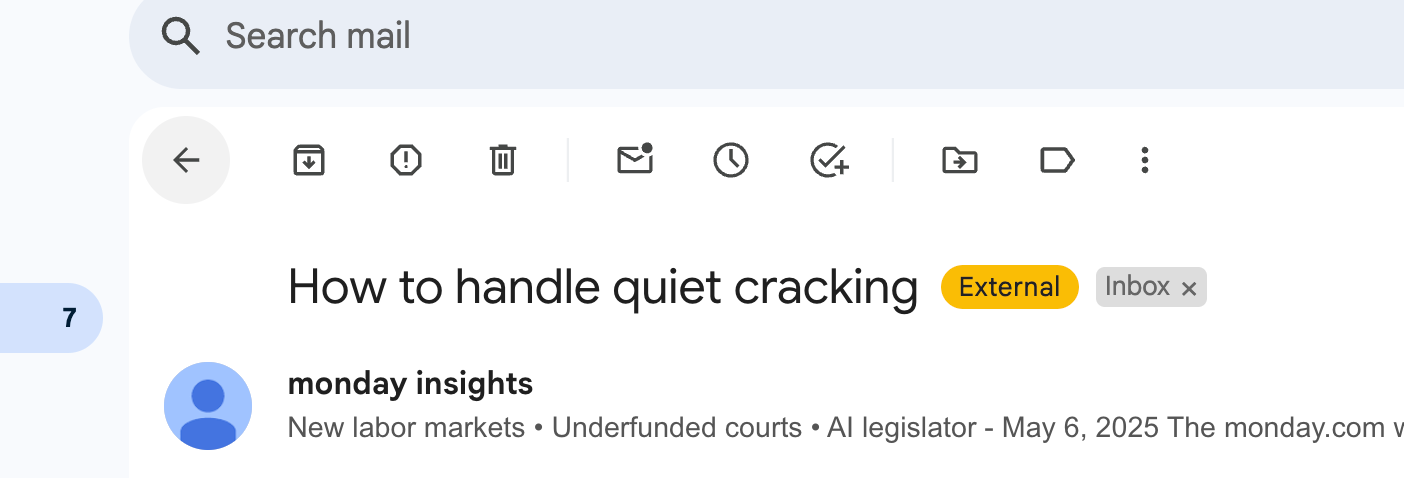I learned a new term today.
There I was, minding my own business, gearing up for a busy day, clearing my inbox, and I saw it— right there, the top email. It noticed it as I hit delete.
I did a double-take as it (and 20 other unread junk emails) disappeared from view. I quickly retrieved it from the email graveyard for a closer look.
What on earth is quiet cracking? I had to know.
I’ve come to deeply trust my sense of signal in the ever-intensifying noise of modern life, particularly when it comes to content that is worth my time to consume. Call it a breadcrumb, my sense of curiosity, a ping, a synchroncity, Godwink, whatever you want. They take me weird places sometimes, but with a long enough rear-view mirror, they’ve never led me astray.
Skimming the email and a few Google searches later, I found the original published article by the research organization, TalentLMS, that identified the phenomenon.
Quiet Cracking: a persistent feeling of workplace unhappiness that leads to disengagement, poor performance, and an increased desire to quit.
A thematic descendant of the 2022 term “quiet quitting,” quiet cracking might actually be worse (for everyone). Both involve a lack of verbal signal, but the impact of the former tends to show up sooner in performance tracking data, whereas the latter mostly reflects in signals with a longer lead time (this is presupposing an organization that is lacking in trust, transparency, direction, and/or structure).
Furthermore, given that
the job market has shifted dramatically in favor of employers,
companies are building and/or buying software infused with AI automations to eliminate headcount,
it strikes me as intuitively obvious that the pulse of the workforce is heading more towards tachycardia than flat-line.
“Quiet cracking” caught my eye because one of the first things I did this morning (before clearing my inbox) was reach out to reassure a distressed colleague. I could tell he was worried about losing his job because the tools he needed to do it weren’t operational this morning. Essentially, his team’s function had been completely blocked by a mistake made by another internal team. Their entire job is to catch such mistakes, and yet I could tell that he was in a state of panic about potentially being punished for literally doing his job.
Is this a strictly rational response? No. But most humans generally aren’t rational, certainly not 100% of the time, and especially not when survival traumas are triggered. My own experience with job instability has absolutely left its mark on me: I've lived it, felt it, fought it. Hell, I navigated a redux of it myself later in the day.
Because of this, I know the signs when I see them. The anxiety, hyper-vigilance, fear, a high-level attunement to any signal that just might be a existential threat. I’ve seen people (and observed myself) express this inner state in two distinct ways— either exhaustively overworking, or developing something I’ve termed learned hopelessness, where the employee comes to expect disappointment at every turn. Both expressions lead to disengagement, broken trust, missed deadlines, and shipped mistakes.
Safe to say— these are poor outcomes for both the organization and the individual.
If you happen to be reading this and it resonates with you, either from the perspective of an employer or an employee, then hopefully naming that ineffable sense of workplace ennui is the first step in helping you put your finger on the problem.
Solving it, however, is another thing.
As friends and any longtime readers may know, I tend to cross-apply frameworks between their intended domains (i.e. work frameworks to solve life problems and vice versa). One phrase that has been coming up for me A LOT outside of the office lately has been this:
“Clarity is kindness.”
I usually whip this one out when I’m either seeking or giving clarity in the dating department, and very often in boundary-setting. But, once again, it strikes me that what is true and useful in life is also profoundly true and useful in building or running a business.
In fact, the TalentLMS article (which I am linking again to encourage everyone to read for the full breakdown of symptoms and treatment protocols for a diagnosis of quiet cracking) takes it one step further with this equally awesome, more tech-bro-friendly, less ew-gross-feelings-oriented version:
“Clarity combats chaos.”
If you’re an employee, and you’re feeling fucking SEEN by the definition of quiet cracking, you need to ask for that clarity.
Align on scope: Get those project requirements and expectations water-tight.
Align on timeline: Get the deadline agreed upon.
Ask for feedback: on your communication, collaboration, and general performance.
If you have a receptive manager, consider sharing what you’re feeling with them. It is okay to ask for help when you need it. You should be encouraged to signal that you are underwater. It’s better for your team if you do.
If you don’t have a receptive manager, you can still try find someone in the org who can potentially give you clarity, look into switching teams, and plan for other contingencies.
If you’re an employer or manager who is noticing signs of anything that sounds like it might be quiet cracking on your team, I urge you to:
Sincerely check in with your reports. I’ve had managers who ask how I am as a social nicety, and I’ve had managers who genuinely show up and want to know. Your reports know the difference. And they’re your best source of clues for determining root cause of the phenomenon.
Heal after conflict, even if it’s not yours. Not all business conversations are sunshine and daisies and cakewalks. If there is a heated debate and you can tell a report probably won’t speak up again after getting hammered by someone else in the meeting, circle up with them to talk about it and encourage that they continue to chime in.
Avoid tactical recognition. I actually disagree with the TalentLMS article that it’s a low-cost, high-impact tool, because when leveraged insincerely, it looks like bullshit (again, we know it when we see it). If you genuinely struggle to find things to praise your team on, you either have a signal detection problem or you should actually consider firing your team (but first, consider asking yourself why they’re like that and how it got this bad?).
Assess your organization’s structural integrity. By this, I mean:
Are you shifting strategies every month?
Do you hold people accountable to their KPI’s or their responsibilities?
Do you have KPI’s?
Are you measuring baselines to gauge improvements?
Does everyone have a clear, well-designed role that they have the tools to successfully execute?
If you started flipping over stones, is there a chance you’d find dysfunctional communication or business relationships, overleveraged key players, or ego-driven leadership?
If you find yourself sweating just thinking about doing any of the above, then that’s exactly where you need to start.
I’m working on another piece in which I analyze Molly’s Game through the lens of James Carse’s notion of infinite games, but it’s worth touching on the concept here as well.
There are at least two kinds of games. One could be called finite, the other infinite.
A finite game is played for the purpose of winning, an infinite game for the purpose of continuing the play.
~ James Carse
When designing a business (which is how I think about instantiating, iterating, and improving upon all the moving parts of a business, from business model to processes to policies to people), it must be designed as an infinite game in order to thrive (and not in a Going Infinite SBF-kind of way) .
People are incredibly complex, and arguably no one has fully cracked the code in how to unlock the all of the potential in an individual. Given everyone’s unique cultural background, life experiences, and present circumstances, it is an impossible problem to solve for everyone in every org. And that’s just at the individual level— the calculus becomes dizzyingly more complex when two or more people are involved and their internal worlds collide. Organizational psychology makes this digestible, extracting some heuristics out of ample research, but I would hazard a guess that these heuristics only hold true generally and at scale. In most organizations, most people are not operating at full-intensity all the time.
In high pressure environments, however, such as startups, masks sometimes slip and gloves can come off.
As a business designer, it earns you nothing to assume that everyone is brave enough to speak up, voice a concern, ask a question, confirm an understanding without fear of judgment or punishment (especially if power dynamics are in play). Such behaviors must be encouraged until sufficient trust has been built. Yes, you can screen for some of these traits in the hiring process, but even if someone passes with flying colors, there’s no guarantee that behavior will hold across time during their tenure or even that the new hire will be compatible with the team.
So, to employers— Know your humans. Tend to them and help them grow. That doesn’t mean coddle them, but it does mean learning how being in business with them can be mutually beneficial. Such aligned incentives are the kind of positive-sum dynamics that drive businesses forward as infinite games. And it does mean taking a good, hard look at environmental factors preventing your team from truly thriving.
To employees— you have agency. Ask for the tools or feedback you need to grow, find or build a support network, and challenge yourself to humbly ask tough questions. Odds are if you’re wondering it, someone else might be, too. Strengthen that muscle. You are your own business, and you are just as capable of being your own infinite game.
Lastly, I want to leave you, employers and employees alike, with this—
Clarity is kindness. Clarity combats chaos.
Kindness combats chaos.
Be kind.





This quiet cracking concept really nails it. Bookmarking this post for future pondering!